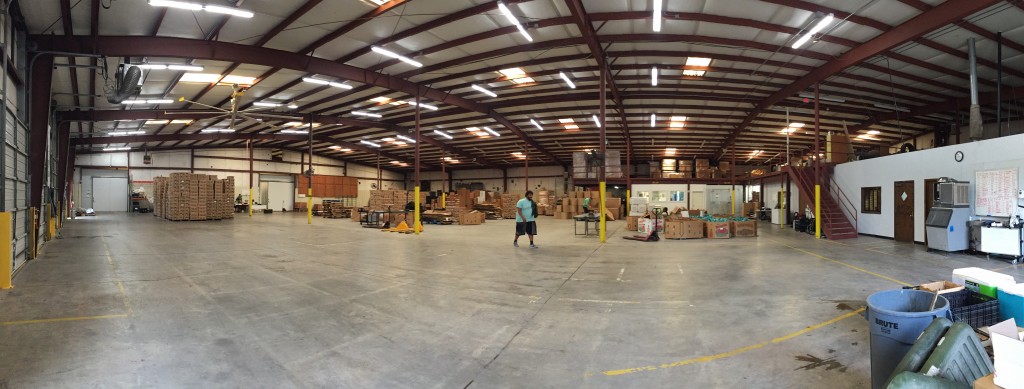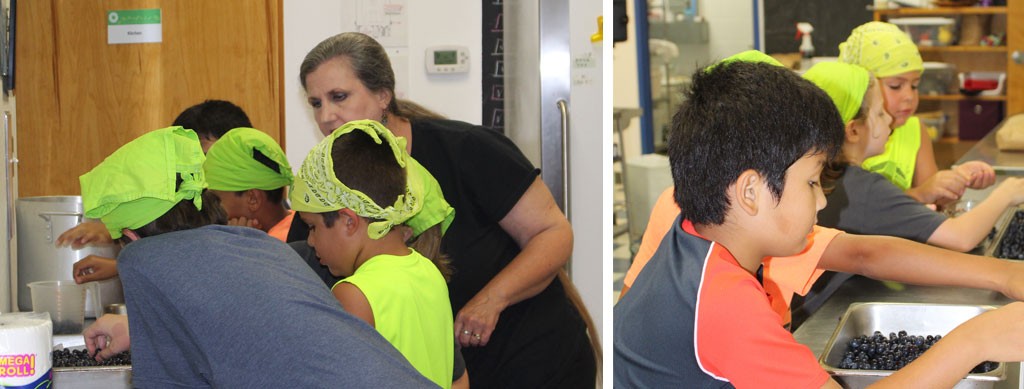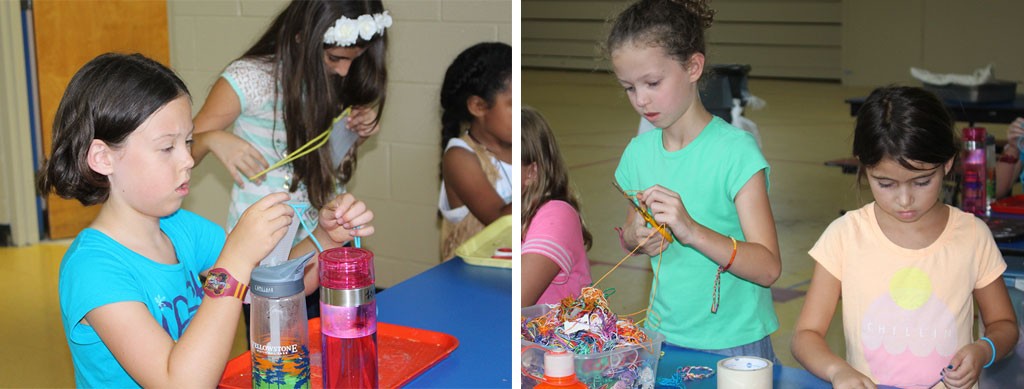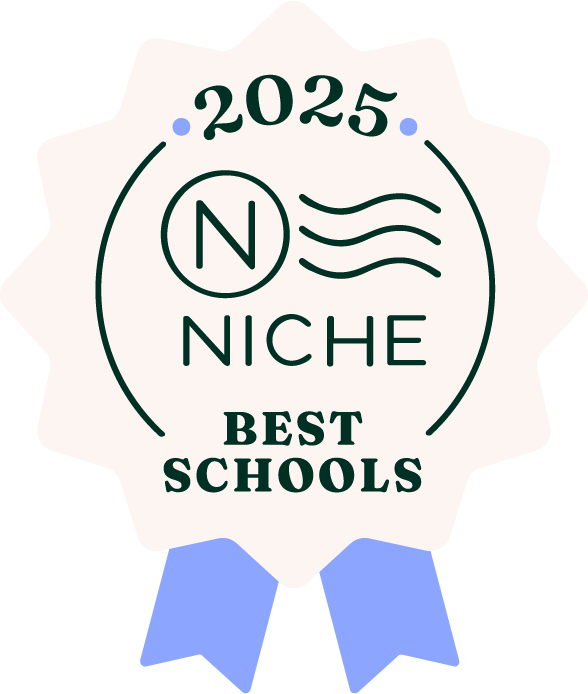Greensboro Montessori School's Upper School students took a leading role in Friday's Earth Day celebration. Upper Elementary students kicked off the morning with readings of original poetry and Spanish. After the program (which we shared live on Facebook), Junior High students hosted Lower and Upper Elementary students at eight different different stations set up on the Athletic Field. Each station featured an activity to to raise awareness for Earth Day, including ideas for recycling, composting, and even limiting our waste. Primary students enjoyed a lesson with our environmental educators, Chelsi Crawford and Sara Stratton. Toddler students took everything in from their shaded mats under the trees, just steps away from their play yards.
The original poetry shared by our Upper Elementary students highlights our integrated curriculum. Students combine their skills in English, Spanish, creative writing, science, environmental education, public speaking, and leadership all at once. We are honored to publish their work for all to experience.
Redbud Tree
Lydia, Sixth Grade
The Eastern redbud tree, purple blossoms in early spring. Small beacons of colour adorn the dull, monochromatic landscape. Bursts that spring is just around the corner.
As the blossoms begin to fade, they get swept away by the gusts of wind that spring brings. Petite purple petals pressed onto the ground as they get trampled by tiny feet. But not all is lost, leaves that are a deep crimson, like garnet, or a sharp, zesty lime the size of a hand unfurl. The leaves are shaped like spades. Desperately trying to hold onto their branches by their paper-thin stems. Through treacherous storms they hold on, not falling yet, for the leaves have roots of their own.
The redbud tree is eternally stretching, reaching its roots through the mycelium and soil, while the branches are competing for the warm rays of sunlight. The uneasy cottontail rests by the roots of the tree, protected by the lush canopy from the hungry hawks’ view.
During autumn, the leaves of the redbud tree glow orange, like a campfire. Only turning into a bonfire as the chorus of the other deciduous trees chime in in the early November. Then, the redbud tree goes to sleep as the long, cold winter days begin.
Día de la Tierra Upper Elementary Group A
- Debemos cuidar la Tierra porque es el único planeta que temenos.
- Debemos cuidar la Tierra porque es nuestra casa y nuestro hogar.
- Debemos cuidar la Tierra porque vivimos en ella.
- Debemos cuidar la Tierra porque hay animales, árboles, océanos y más.
- Debemos cuidar la Tierra porque es la casa para todos los tipos de vidas.
- Debemos cuidar la Tierra porque nos da comida.
- Debemos cuidar la Tierra porque es la casa de todos.
- Debemos cuidar la Tierra porque es muy bonita. Los humanos debemos comprender que no se debe hacer daño a la Tierra.
- Debemos cuidar la Tierra porque o si no nos extinguieremos.
- Debemos cuidar la tierra porque es nuestra protectora y nuestro hogar.
sphagnum
Tanner, Fourth Grade
The sphagnums dance in the rain like an umbrella being twirled. The sphagnums dance in the rain on the mother tree. The sphagnums dance in the rain in the rainforest. The sphagnums dance in the rain under the shade. The sphagnums dance in the rain and the damp mother tree is playing her music. The sphagnums dance in the rain, their spore capsules open up and the spores fly away. The sphagnums dance in the rain as the 10,000 ancestors watch them. The sphagnum dances in the rain, the calm green color is shimmering on as the rain falls on them, the sphagnums dance in the rain; they have no roots, stems, leaves or seeds. The sphagnums dance in the rain, they can grow until they run out of room. The sphagnums dance in the rain in their fuzzy soft coats. The sphagnums dance in the rain. They are used for medicine to save peoples lives. The sphagnums dance in the rain; they get picked and re-planted to make a garden look nicer. The sphagnums dance in the rain.
Greensboro Montessori School's Junior High students just culminated one of their project based learning assignments – hatching, growing, and releasing brown trout.
Junior High science teacher, Tim Goetz, released the trout in a cold water tributary of the Smith River near Bassett, Virginia. It was a Friday morning in the middle of the COVID-19 pandemic. Normally, our Junior High students would have been stream-side with Tim, and it would have been their job — not their teacher's — to complete the final step of their semester-long project. Instead, students joined Tim virtually to watch the trout meet their natural habitat.
As the trout grow, they will make their way up river into the Smith River. Along the way, they will eat land and water insects, zooplankton, worms and other aquatic creatures. They will also search for hiding places from predators, including birds and other fish. Tim Key, a member of the Nat Green Fly Fishers Club, who was present at the release said "these are some of the best fish I have every seen."
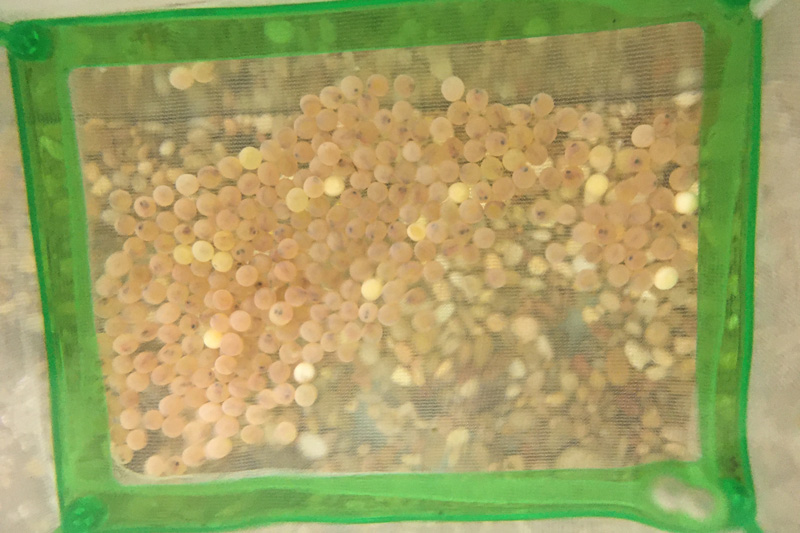 The fish were hatched at Greensboro Montessori School as a part of the nationwide Trout in the Classroom program, with support from the Dan River Basin Association, and Tim Key of the Nat Greene Fly Fishers Club. Over 250 eggs were given to the School on December 5, 2019 and the first hatch was December 10.
The fish were hatched at Greensboro Montessori School as a part of the nationwide Trout in the Classroom program, with support from the Dan River Basin Association, and Tim Key of the Nat Greene Fly Fishers Club. Over 250 eggs were given to the School on December 5, 2019 and the first hatch was December 10.
The fish were raised in a 45-gallon, cold-water aquarium at 50 degrees Fahrenheit in Greensboro Montessori's Upper School. To quickly prepare the correct growing environment, students mixed five gallons of water from the School's pond with 40 gallons of tap water. Students tended to the fish daily, including feeding, changing water, and water testing. Daily water tests included pH, ammonia, and nitrites with the goal of recreating a natural, cold-water trout habitat. This attention to detail resulted in the science room smelling more like an outdoor classroom next to a river than a traditional classroom.
Eighth grade student, Nina, was the head aquarium tender and her classmate, Ava, provided the backdrop art for the aquarium.
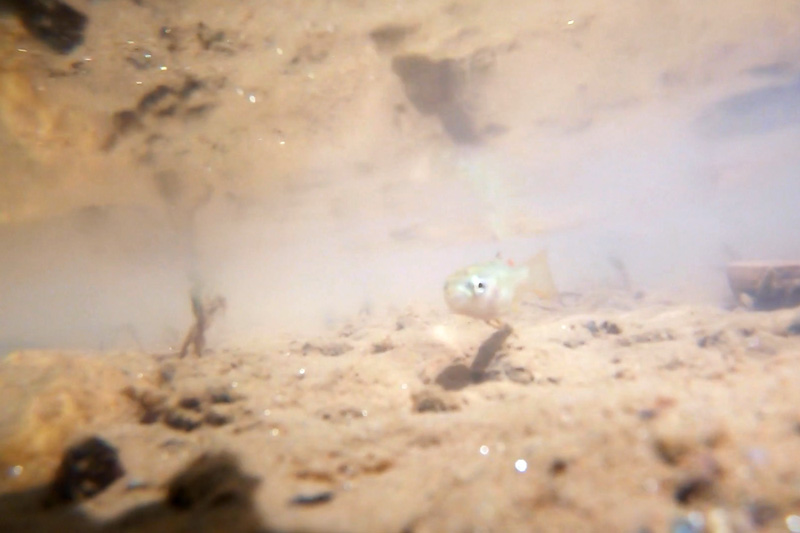 Prior to COVID-19, Junior High students were scheduled to travel to Virginia to release the trout themselves. Their expedition would have been part of their April Land Week, one of several weeks a year when they learn at Greensboro Montessori School's 37-acre satellite campus in Oak Ridge, N.C. With schools throughout the state suspending in-person learning, the students' land week and field trip was cancelled, but not their learning. Students participated in the trout release through a Live Lesson via Google Hangouts. Tim also documented the release on GoPro cameras so he could share the experience with the entire school community, Toddler through Junior High. After all, Greensboro Montessori School students learn everywhere, whether its the indoor, outdoor, or virtual classroom.
Prior to COVID-19, Junior High students were scheduled to travel to Virginia to release the trout themselves. Their expedition would have been part of their April Land Week, one of several weeks a year when they learn at Greensboro Montessori School's 37-acre satellite campus in Oak Ridge, N.C. With schools throughout the state suspending in-person learning, the students' land week and field trip was cancelled, but not their learning. Students participated in the trout release through a Live Lesson via Google Hangouts. Tim also documented the release on GoPro cameras so he could share the experience with the entire school community, Toddler through Junior High. After all, Greensboro Montessori School students learn everywhere, whether its the indoor, outdoor, or virtual classroom.
Learning through purpose-filled, project-based learning — like hatching, raising, and releasing brown trout into their natural habitat — is not the exception to the rule at Greensboro Montessori School. It is the rule. Our students learn through completing meaningful work, which often results in real-world benefits to the community. Through the multistep process of researching, designing, implementing, refining, analyzing, and presenting their projects, our students gain real-world skills such as resiliency, creativity, curiosity, time management, and public speaking. They also develop a sense of self-worth by understanding the value of their contributions to society and experiencing personal fulfillment.
Click here to read about about another real-world project our Junior High students are leading: inoculating, growing, harvesting, and selling shiitake mushrooms.
In addition to Trout in the Classroom, Dan River Basin Association, and Nat Greene Fly Fishers Club, Greensboro Montessori School would like to thank Oliver Rouch from K2 Productions for lending us GoPro cameras and editing our release footage. We also want to thank Tim Key for his work behind the camera.
My very first year at Greensboro Montessori School, I worked alongside a wise and wonderful teacher, who is also my Montessori mentor. As our year together progressed into late spring, she suggested we teach a unit on the life cycle of the monarch butterfly and sent me afield to pick up a caterpillar tent from a local butterfly farm. It was a curious-looking contraption: a flowering milkweed plant with a gauzy covering. A week into our journey with this kit, my mentor had a family emergency that took her on an unexpected trip overseas ... for four weeks. At a moment’s notice, I found myself entrusted with the care of 12 children; one gerbil (my mentor knew I didn’t do rodents); a ragtag tray of fava beans sprouting in paper cups; and this milkweed plant, the presumed setting for the miracle of metamorphosis. That is, if I could keep it alive. It didn’t take long for me to realize that with this lowly plant came some extraordinary lessons in faith, respect, awe, tenderness, and trust.
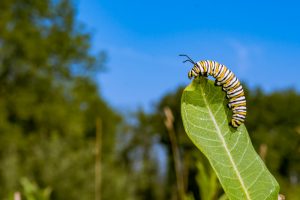 For those uninitiated in the art art of raising caterpillars: they take a while to become visible. A long while. Though we’d been promised that our plant came with a pair of Monarch eggs, those first two weeks rolled by with nary a sighting of the little beasts. Every day we checked for them, and every day I saw the skepticism grow in my students' eyes as I described the wondrous sight we were going to behold. Probably. Eventually. The morning we finally noticed wormholes in the leaves — evidence that our charges were indeed hatched and hungry — felt like waking up to breakfast in bed on your birthday.
For those uninitiated in the art art of raising caterpillars: they take a while to become visible. A long while. Though we’d been promised that our plant came with a pair of Monarch eggs, those first two weeks rolled by with nary a sighting of the little beasts. Every day we checked for them, and every day I saw the skepticism grow in my students' eyes as I described the wondrous sight we were going to behold. Probably. Eventually. The morning we finally noticed wormholes in the leaves — evidence that our charges were indeed hatched and hungry — felt like waking up to breakfast in bed on your birthday.
Once our caterpillars became visible, they grew at a blazing speed, delighting the toddlers with their impossibly lovely stripes and ravenous eating habits. The students relished the idea that these creatures never, ever accepted any food but milkweed. “Wouldn’t you like some pizza, dears?,” I’d ask the worms. “Maybe a nice cup of coffee?” The children would squeal, “NO WAY!,” perhaps reminded of their own choosy appetites. An assortment of suggested names were bandied about, ranging from Lexy to Tiger to Dobo to Burp. (The caterpillars didn’t seem to have a preference.)
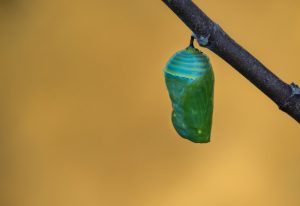 One sunny morning, we found the caterpillars hanging from the leaves in their mysterious “J” formation, the behavior that immediately precedes the formation of the chrysalis. Within hours, they were caterpillars no more. If I had not seen it with my own eyes, I could never have imagined the reverence and care the students extended once this transformation had taken place. They seemed to instinctively know their tiny pets now needed silence and space. Each morning, the toddlers took turns standing guard by the milkweed plant, gazing solemnly at the astonishing beauty of the chrysalises, misting them gently with a spray bottle. Many days of inaction followed ... yet, having awaited their friends’ first emergence, the students now had unwavering patience and faith. Some miracles, they’d learned, are worth waiting for.
One sunny morning, we found the caterpillars hanging from the leaves in their mysterious “J” formation, the behavior that immediately precedes the formation of the chrysalis. Within hours, they were caterpillars no more. If I had not seen it with my own eyes, I could never have imagined the reverence and care the students extended once this transformation had taken place. They seemed to instinctively know their tiny pets now needed silence and space. Each morning, the toddlers took turns standing guard by the milkweed plant, gazing solemnly at the astonishing beauty of the chrysalises, misting them gently with a spray bottle. Many days of inaction followed ... yet, having awaited their friends’ first emergence, the students now had unwavering patience and faith. Some miracles, they’d learned, are worth waiting for.
When the butterflies emerged during the last week of school, we carried them to the playground and prepared to set them free. Before they departed, they allowed each and every toddler to hold them awhile and sing them a send-off song (the choice was painfully obvious: “Let it Go”). When the monarchs finally took to the sky and fluttered toward the Primary garden, I knew the students and I were feeling the exact same mix of elation and heartache. After all, many of our toddlers themselves would soon be flying to the other side of the playground fence, away from the nest of our classroom and our many loving days together.
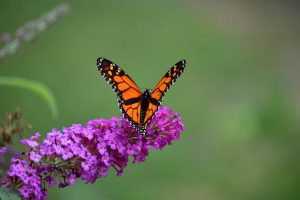 Six years later, having raised monarchs with every single toddler class I’ve taught since that first year, it’s time for my own metamorphosis. I am so excited for the new challenges and relationships that await me as I transition into the director of CASA role at Greensboro Montessori School. Yet there’s something about teaching that simply can’t be matched by any other profession. Year after year, I’ve witnessed the beautiful metaphor of little children caring tenderly for the tiny, fragile caterpillars whose lives begin in our classroom. I hope that’s in small part because they, too, have felt tenderly cared for here; that they understand the reverence and awe a teacher experiences as they watch their students grow, and the bittersweet pride they feel when it’s time to set their students free.
Six years later, having raised monarchs with every single toddler class I’ve taught since that first year, it’s time for my own metamorphosis. I am so excited for the new challenges and relationships that await me as I transition into the director of CASA role at Greensboro Montessori School. Yet there’s something about teaching that simply can’t be matched by any other profession. Year after year, I’ve witnessed the beautiful metaphor of little children caring tenderly for the tiny, fragile caterpillars whose lives begin in our classroom. I hope that’s in small part because they, too, have felt tenderly cared for here; that they understand the reverence and awe a teacher experiences as they watch their students grow, and the bittersweet pride they feel when it’s time to set their students free.
This year, when our current crop of monarchs depart for the great big world outside, we’ll all be ready to spread our wings and join them, together, in flight.
 About the Author
About the Author
Brooke Juneau joined Greensboro Montessori School's Toddler faculty in 2013. She holds her Infant & Toddler (bith to 3 years old) Montessori teaching credential and graduated from Hampshire College with a Bachelor of Arts in education and human development. Brooke is the mother of three boys. Her middle son, Hayden, graduated from Greensboro Montessori School in 2017. Brooke plays the guitar and loves singing with her students. Beginning in the 2019-20 school year, Brooke will be the School's director of CASA.
“Turn it, and turn it, and turn it, and turn it, and turn it, and turn it, Compost Cake!”
“Pile it high, pile it high, pile it high, Compost Cake!”
If you’ve heard this song about compost all around campus this fall and winter, it’s because we got new compost bins in the Primary and Lower Elementary gardens! Why did we get new bins, you might ask? Two reasons:
- We needed more space for the volume of organic waste we produce (a combination of garden waste and food scraps from the students' lunches and snack preparation)
- We wanted to try a more interactive, faster, and developmentally appropriate compost model for our younger students.
So what did we get? If you visit the Primary and Lower Elementary gardens, you’ll see some giant green cylinders sitting on a rotating axis. These compost bins are called tumblers. Tumbler compost models allow students of all ages to spin the compost (working those gross motor skills), in addition to speeding up the composting process. In our old bins, it took at least a year for our food waste and garden scraps to decompose fully, we'll make finished compost in as little as two weeks. Cheers to that!
What is Compost?
Compost is the product that’s left after organic matter has fully decomposed. It’s also called humus. Human-made compost comes from carefully mixing food and garden waste materials — ingredients high in either nitrogen or carbon — and placing them in an environment where they can decay. When the decaying process has gone well, we put the finished compost, or humus, back into the garden soil and grow healthier plants by improving soil fertility.
Why do we compost at Greensboro Montessori School?
For starters, compost has a longer ground-life than other fertilizers. It lasts longer in soil than crop residues or animal manures that degrade rapidly here in the humid Southeast. This longevity makes for healthier plants and food crops. Composting also reduces our waste throughout campus. By diverting organic matter from the landfill and into a closed-loop cycle, we transform our “waste” into a fertilizer for our gardens and food for the microorganisms that live in the soil beneath us. We also save money by eliminating the need and associated cost of additional soil fertility inputs. And let's not forget, composting is just plain fun!
Can you think of any other reasons to compost? Maybe, that by doing it, we are feeding the worms our Toddlers so adore? That it’s a responsible use of resources? That it's a project-based way to teach science? Share your thoughts with us! And, if you want to learn more, please join us at our next Community Garden Workday for more composting tips and tricks with our environmental education faculty. We’d love to have you.
If you're interested in learning more about the science of composting, read this article from Live Science.
 About the Author
About the Author
Eliza Hudson is Greensboro Montessori School's lead environmental educator. Eliza holds her bachelor's degree in biology from Earlham College in Richmond, Ind. She has built and tended school gardens, taught hands-on cooking lessons and connected local farms to school programs working for FoodCorps. Prior to joining Greensboro Montessori School in 2014, Eliza was a classroom and after-school assistant at the Richmond Friends School, a farm intern at a family-owned farm in Ohio, and served as assistant director at a summer day camp in an urban community garden in Durham.
Greensboro Montessori School has taught environmental education since 1995 and has been permaculture gardening on its campus since 1997.
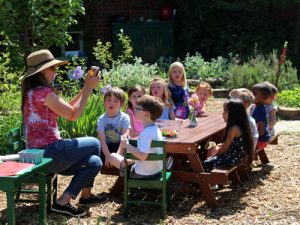
Sara Stratton leads Primary students in making dressing for their strawberry spinach salads.
Springtime is always joyful in Greensboro Montessori School's organic gardens. Winter buds swell and burst, capturing the eyes and hearts of community members, no matter their age! Flowers of all kinds call to us and to our pollinator friends, and sooner than we realize, we reach the height of the season.
This year brought a colder and wetter forecast than in the past. We’ve still yet to harvest our first sugar snap peas, but the strawberries and spinach are out with a vengeance! We continue to enjoy the lushness all the early rain and cool weather brought, even as temperatures rise. Here’s a brief update from our spring adventures!
Primary and Lower Elementary have enjoyed plenty of weeding, watering, planting, and tasting. We just finished a week full of strawberry spinach salads, with a bit of fennel and spring onions thrown in for fun! (Check out the recipe below if you’re interested in trying this at home.) In Upper Elementary, we celebrated the conclusion of our Student Climate Change Summit art exhibition with a persimmon-ginger-honey ice-cream party! Everyone agreed it was fun to make and even better to taste!
Thanks to everyone who attended our Spring Community Garden Workday in the Primary Garden. Together, with roughly 20 volunteers from our school community (ranging in age from 18 months to 70 years old!), we had a blast and accomplished a swath of projects:
- A group of students and dads built a blackberry trellis.
- Sara Stratton supervised several painting projects: our new fence, sink, and picnic tables got all glammed up in a matter of minutes!
- Another dad mixed concrete, which every child who came to the workday used to make a decorative stepping stone.
- Nearly everyone weeded, watered, snacked, swept, and generally left the space looking wonderful for the students, faculty, administration, and all the special guests we welcome in the spring!
What else have we been up to in the organic gardens this spring? We have been incredibly blessed with the generosity of The Fund for GMS. You may have noticed several new Adirondack chairs, benches, swinging benches, outdoor sinks, and chalkboards in all three of our organic gardens. We also have a new Lower Elementary toolshed coming soon. The students have relished in these new additions to their outdoor classrooms, and we couldn’t be more grateful to have such gifts shared with us from within our school community. Thank you, for your continued support of environmental education at Greensboro Montessori School. From all of us on your environmental education teaching team, Happy Spring!
Strawberry Spinach Salad
For the salad:
- 1 pound fresh spinach, washed and spun
- 1 pound fresh strawberries, washed and dried
- 2-3 spring onions, optional
- 2-3 leaves fennel, minced
For the dressing:
- 1/4 cup olive oil
- 1/8 cup balsamic vinegar
- 1 tablespoon honey
- 1 pinch cinnamon
 About the Author
About the Author
Eliza Hudson is Greensboro Montessori School's lead environmental educator. Eliza holds her bachelor's degree in biology from Earlham College in Richmond, Ind. She has built and tended school gardens, taught hands-on cooking lessons and connected local farms to school programs working for FoodCorps. Prior to joining Greensboro Montessori School in 2014, Eliza was a classroom and after-school assistant at the Richmond Friends School, a farm intern at a family-owned farm in Ohio, and served as assistant director at a summer day camp in an urban community garden in Durham.
Greensboro Montessori School has taught environmental education since 1995 and has been permaculture gardening on its campus since 1997.
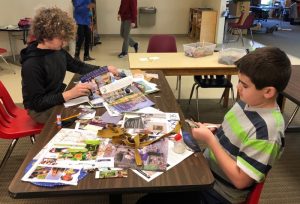 What do you love in the world and think is worth preserving?
What do you love in the world and think is worth preserving?
Upper Elementary students wrestled with this important question during their class project for the Green and White Bash silent auction. My daughter, Stella, is a student in the Upper Elementary classroom, and I was privileged to assist the children in transforming two blank puzzles into a lively mixed media college. Since the Bash’s theme was “sustaining our future” through the funding of student scholarships and staff professional development, I thought it would be fitting for the class project to address this idea of sustainability. So, I asked each student to design a single puzzle piece that identified their own personal junction of love and preservation. All the pieces joined together to form a single, unified collage.
The project turned out to be both intellectually and artistically challenging for the class. Some of the students needed clarification on the question and took extra care to reflect on the conceptual differences among sustainability, preservation, and conservation. Others thought of multiple ideas and found it hard to choose a single focus for their piece. They would sit in thoughtful silence, rifle through magazines for inspiration, or simply run off to do something else, planning to return later. For other children, the process was easier and they settled into their work instantly. Regardless of how quickly their work progressed, it was humbling to witness the moment when each child’s idea clicked into place. You could sense the wave of clarity and purpose wash over them as they set themselves to task. They would sift through the huge pile of assorted collage papers and magazines and dig through buttons, cork, sequins, pom pom balls, threads, beads, and other odds and ends to find the perfect color, texture, or imagery to convey their idea.
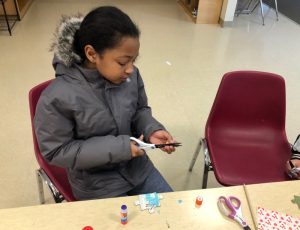 The students’ approaches to composition varied as dramatically as their themes. Some enjoyed working very flat, while others preferred a more 3D composition. Some students chose clipped images and text, while others wanted to incorporate their own drawings. Some designed beautiful miniature scenes of forests and picnics, while others worked more conceptually and built up layers of interest. Each piece was transformed into a unique and carefully crafted work of art.
The students’ approaches to composition varied as dramatically as their themes. Some enjoyed working very flat, while others preferred a more 3D composition. Some students chose clipped images and text, while others wanted to incorporate their own drawings. Some designed beautiful miniature scenes of forests and picnics, while others worked more conceptually and built up layers of interest. Each piece was transformed into a unique and carefully crafted work of art.
After the last student finished, I packed up all of the supplies and took everything home to (literally) put the pieces together. As I assembled the individual pieces into a finished collage, I was amazed by how well the variety of themes and designs worked together. Thirty-seven distinct responses to a single question had morphed into a microcosm of our beautiful, crazy modern world. Elements of nature (birds, oceans, trees) wove through interpretations of social life (family, friends, holidays) and modern living (technology, medicine, Disney). The Upper Elementary class project about sustainability had become an ecosystem of gratitude and hope for the future, where nature merges seamlessly with people, technology, and traditions: very much like a day at Greensboro Montessori School!
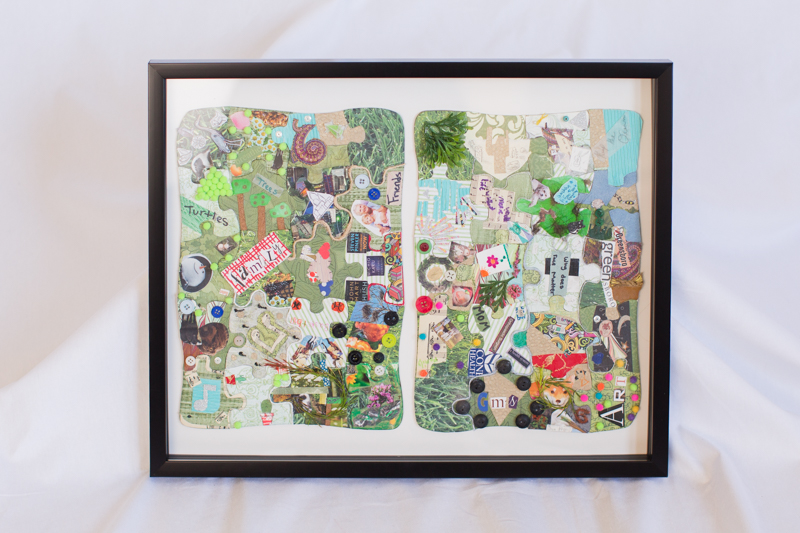
 About the Author
About the Author
Gina Pruette is a parent and regular substitute teacher at Greensboro Montessori School. In addition to her commitment to the School, Gina is an active volunteer within the greater Piedmont Triad community where she leverages her expertise in marketing and events planning, fundraising, and tech solutions to further the missions of various nonprofit organizations. Gina recently completed Racial Equity Training through the Racial Equity Institute to strengthen work with diverse populations, and she holds a bachelor of arts from the University of Pennsylvania.
Greensboro Montessori School's mission is to nurture children to be creative, eager learners as they discover their full potential and become responsible, global citizens.

Primary sweet potato biscuits keep students warm on a cold morning.
At Greensboro Montessori School, Environmental Education Curriculum is based on seasonal cycles, the outdoor environment at the School, and the age of the students. We invite spontaneity and often pause to watch and identify insects, marvel at life in the garden, and discuss questions or insights as a community. In all levels we teach about soil, decomposition and compost, pollination, and biodiversity. But what is it we do in winter when the gardens are resting? The short answer is, we teach seasonality and ecology in organic gardens.
Primary students study birds, concentrating on basic identification by sight and sound. They love making binoculars (out of recycled toilet paper rolls) and using them on our bird walks around campus. Along the way, they learn to empathize with birds and their needs, to stop and slow down as not to miss a moment of wonder, and to make an ecological connection between our gardens and the needs of birds: shelter, food, water, and spaces to nest. As the weather warms up, we explore our winter stores of food from the fall gardens - sweet potatoes, garlic, ginger, and honey - in cooking classes, and venture outdoors to observe and relish in the signs of spring!
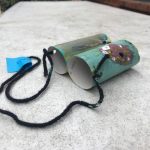
Lower Elementary students' binoculars are treasured tools in class this month.
Lower Elementary students delve even deeper into their bird study, concentrating not only on the basic identification of birds, but also on prolonged observation of bird behavior, habitat, and appreciation for their ecological significance in our organic, permaculture gardens. They love learning how to use and read field guides like ornithologists! I find bird study with this age is a wonderful way to remind children how to sit and soak in the surrounding environment, something we often don’t take time to do when the garden gets growing in spring. Bird watching in winter offers students opportunities to experience peace, critical thought, and insight that they so desperately need after the holiday rush and just before the end of year crunch! As spring break draws near, we share our bird findings with area scientists, cook with our winter food stores, and begin preparing ourselves for spring planting in the garden.
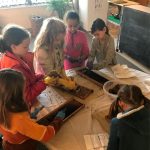
Upper Elementary students save bees wax from a hive that died over the winter. Honey bees and other native bees are a focal point for these students' climate change project.
Upper Elementary winter studies range from native tree and animal projects to redesigning of our Upper School outdoor classroom. This year, we're up to something BIG ... we’re tackling the subject of climate change and how it affects each of us and our experience at Greensboro Montessori School. We're thrilled the culmination of this project will include an art installation we collectively create and participation at the Student Climate Change Summit at UNCG on March 29. The event will be from 5 to 8 p.m. at Weatherspoon Art Museum. Open to the public, the Student Climate Change Summit will feature a wide-array of student participants representing several generations. In addition to our Upper Elementary students presenting their artwork, undergraduate students from UNCG will present research posters around a variety of climate change topics. A student from NC State will describe the work of The Climate Reality Project Campus Corps on their campus. Last but not least, students from the International Baccalaureate (IB) Program at Grimsley High School will present posters highlighting their IB papers on climate change. We hope you will join us at Weatherspoon Art Museum on March 29!
 About the Author
About the Author
Eliza Hudson is Greensboro Montessori School's lead environmental educator. Eliza holds her bachelor's degree in biology from Earlham College in Richmond, Ind. She has built and tended school gardens, taught hands-on cooking lessons and connected local farms to school programs working for FoodCorps. Prior to joining Greensboro Montessori School in 2014, Eliza was a classroom and after-school assistant at the Richmond Friends School, a farm intern at a family-owned farm in Ohio, and served as assistant director at a summer day camp in an urban community garden in Durham.
Greensboro Montessori School has taught environmental education since 1995 and has been permaculture gardening on its campus since 1997.
If you stroll through our school gardens on any given Monday afternoon, you are likely to find Marcia Jones volunteering alongside our lead environmental educator, Eliza Hudson. As a retired educator, Marcia looks forward to her weekly gardening class with our Primary students, and with her 31 years of experience as a kindergarten teacher in Guilford County, we look forward to all she has to offer the children and the school. In a recent interview, Marcia shared with us how much she loves teaching young children the value of tending the earth, especially her four grandchildren including Foster, who is enrolled in our Primary program.
In addition to helping in our gardens on a weekly basis, Marcia supports several other community gardening projects in and around the Greensboro area. She uses her green thumb to tend the gardens at the Wentworth Museum in Rockingham County, the Guilford College Community Garden and Jones Elementary School. “Gardening helps me relax,” Marcia shared, "and its so nice to be able to see the product of all your effort. I think that’s especially true for young children." Many years ago, she started a gardening program with her kindergarten students at Sedgefield Elementary School. “The children loved it. We grew a wide variety of vegetables from seed, including squash, radishes, potatoes, peas, and pumpkins. The children especially liked the pumpkins because they would grow all summer and could be harvested in the fall,” she shared.
With her family’s roots in this area of North Carolina, Marcia is deeply connected to the land, and her knowledge of farming is much greater than what her humble demeanor might initially suggest. She grew up working on her family's farm in Rockingham County just north of Greensboro and she has many fond memories of driving the tractor out in the fields. “My sister and I were working on the family farm up until two years ago. Over the years, we’ve grown tobacco, corn, wheat, soybeans and apples.” Even with those years of experience in her back pocket, Marcia continues to express her modesty about having a green thumb and loves learning new gardening techniques from those around her. “Lately, I’ve been learning more about which herbs to plant around my vegetable garden to deter deer and other wild animals,” she told us.
With Greensboro Montessori School's tuition payments dedicated to covering Greensboro Montessori School’s operating expenses, grants from the Annual Fund provide the necessary resources to make our School more than excellent - to make us truly exceptional. Through the benevolence of parents, alumni, community partners and friends of the School who give to the Annual Fund, Greensboro Montessori School is able to award grants biannually to teachers and students with specific classroom needs or transformative ideas or both!
Current year grants are funded by the previous year's giving. Contributions generously given and humbly received from last year's Annual Fund have begun taking shape through five grants awarded this fall. They range from simple classroom enhancements for our littlest students to significant technology investments for our elementary programs to supplies for creating a new ecosystem on campus (starring chickens) for our oldest scholars.
- Better Sleep for Growing Toddlers: The Academic-Day Toddler class received three new, high-quality Roman shades with blackout liners to help students get better sleep during nap time. While shades may seem simple to us, anything to promote sleep for our littlest students is transformative. The National Sleep Foundation says, "sleep is especially important for children as it directly impacts mental and physical development...During the deep states of [Non-Rapid Eye Movement] sleep, blood supply to the muscles is increased, energy is restored, tissue growth and repair occur, and important hormones are released for growth and development.
- Reading and Technology Resources for Lower Elementary: With four new Dell Chromebooks and a Raz-Kids subscription, the Lower Elementary program has increased access to age-appropriate, education-based technology. With dedicated laptops in the classroom, students will learn techniques for effective and safe online research and word processing skills. They will also be able to easily practice coding and have seamless access to their Raz-Kids online reading comprehension program. Furthermore, the use of PCs in Lower Elementary prepares students to be "bilingual" in the computer world. In many instances, we as adults use Apple products at home and PCs at work, or vice-versa, so ensuring our student have access to both platforms is important.
- iPads for Elementary Artists: In a continuation of Katherine Gwynn's exploration of the symbiotic relationship between creating with technology and hands-on art making, Greensboro Montessori School's art studio is now home to five iPad Airs and an iPad Pro. Students will integrate drawing, painting, digital photography, digital storytelling, animation and more through these new resources exclusive to our art curriculum.
- Chickens for Middle School Entrepreneurs: After 18 months of planning by students in the R&D (research and development) career track, the Middle School is developing a new ecosystem on campus for chickens. Working closely with Aubrey Cupit, Greensboro Montessori School's garden manager and owner of Gate City Harvest, Middle School students are building a mobile chicken coop, complete with a heat lamp, waterer and feeder for six chickens. Egg production will support the Land Lab, Maria's Café and other microeconomy programs. The coop will also include a technology cart with solar panels to power the coop's heat lamp. The mobile solar panels will also complement science lesson and provide a new power source at the Land.
- Ice for Bumps, Bruises, Food Prep, Entertaining and More: Until recently, we've been stocking our freezer with bags of ice. With a new industrial-grade ice maker, we've traded-out the ongoing cost of purchasing ice with a once-time cost to help us make it on our own (how Montessori of us)! The new ice maker supports the entire student-population ensuring a relatively unlimited supply of ice packs for minor student injuries. This resource will also keep our water and lemonade cold for guests at community events like the Fall Festival, Green & White Bash and End of the Year Pizza Party. Lastly, the Middle School will enjoy easy access to ice for Maria Café and trips to the Land.
Our fall grants are as varied as they are inspiring, but there are two things which bind them all. They are not only the result of giving, but also the reason for giving.
For everyone who has given in the past, is giving today or will give in the future, thank you for supporting Greensboro Montessori School. We are who we are because you have invested in us, and we promise to pay it forward by investing everything we can and all that we have in our students.
This summer I've been introduced to Montessori Market, a summer camp Greensboro Montessori has offered for the last 17 years. Through a unique blend of environmental education and hands-on learning, campers participate in a week-long business preparing consumer goods for sale to the general public at the conclusion of camp. Just as our 2016 graduating class impressed me, Montessori Market has revealed yet another School tradition which is so much more than meets the eye.
Montessori Market is an all-hands-on-deck camp featuring contributions from the entire school community. Whatever produce we can't harvest from our own permaculture gardens, we source from local farmers. Both faculty and students work together to gather ingredients before camp even begins. This year, Nancy Hofer, Mary Jacobson, Kristy Ford and Andi Bogan chaperoned our Lower Elementary Al Fresco summer camp students to a local blueberry farm where they hand picked blueberries for jam. We also needed peaches which led me to think about The Produce Box, a service which delivers fresh produce from North Carolina farmers to my doorstep each week. After one quick trip to Raleigh and the overwhelming generosity of The Produce Box, we had boxes of peaches, certified organic zucchini, green bell peppers, corn, jalapeños and tomatoes.
The students began camp with a full refrigerator of fresh, North Carolina-grown produce and three sprawling gardens from which to pick fresh basil for pesto and lavender for sachets. They have also made a wide variety of handmade crafts to accompany their foodstuffs.
As the students approach the end of the week, the most beautiful and compelling aspect of camp comes alive. With finished goods ready for sale, you have to wonder, "for whom and to whom will they sell their goods, and where?" I've since learned that Montessori Market has always worked for the benefit of children in need. Campers wake up bright and early to sell their products at the Greensboro Farmers Curb Market on the Saturday immediately following camp, and all proceeds are donated to a charity focused on kids. Hence, it's time to introduce BackPack Beginnings.
Founded six years ago by Parker White, a new mother at the time, BackPack Beginnings' mission is to deliver child-centric services to feed, comfort, and clothe children in need in Guilford County. By ensuring food and basic necessities are given directly to children in need, BackPack Beginnings makes a positive and lasting impact on their health and well-being. As a 100% volunteer organization, BackPack Beginnings serves over 6,000 children experiencing hunger and trauma in our community annually. Recently, Parker has been named one of four finalists for The NASCAR Foundation’s Sixth Annual Betty Jane France Humanitarian Award presented by Nationwide. This award honors incredible volunteers from across the country who have made a profound impact on children’s lives in their community. (You can vote for Parker daily from now until September 26; if she wins, The NASCAR Foundation will make a $100,000 donation to BackBack Beginnings.)
Our Montessori Market campers have been learning, cooking, and collaborating on behalf of BackPack Beginnings all week. This Saturday, July 30, they will be at the Curb Market proudly displaying their finished goods, and a donation to BackPack Beginnings will allow market-goers to shop from their products. In addition to the pesto and sachets, shoppers may also select from blueberry jam, peach jam, salsa, zucchini bread, and a number of homespun crafts.
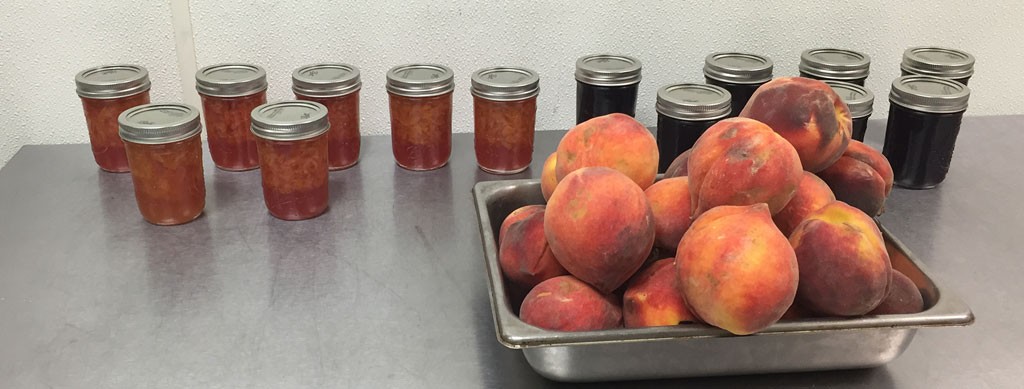
Peach and blueberry jams—lovingly made by students participating in Montessori Market—ready for display at the Greensboro Farmers Curb Market.
100% of the donations received on Saturday will assist the BackPack Beginnings' Food BackPack Program which helps fight childhood hunger in our community by filling the weekend food gap for children in need. By the numbers, this program sends 1,600 children from 26 schools with fresh food each weekend totaling 6,400 food bags per month. This effort is in addition to their Comfort BackPack, Food Pantry and Clothing Pantry programs. While our hope is that we receive enough donations on Saturday to empty our booth, any remaining products can be directly donated to BackPack Beginnings for direct inclusion in Food BackPacks or the Food Pantry.
So this is the story of how a summer camp evolves into so much more than a summer camp. How the Montessori philosophy challenges us, as adults, to push our kids to do more than text, snapchat and Netflix during summer break. How engaged faculty and community organizations prepare children for a lifetime of success by providing real-world experiences in running a business, manufacturing, time management, and philanthropy. And how children come together to help others less fortunate than themselves. And how Montessori Market is more than meets the eye.

